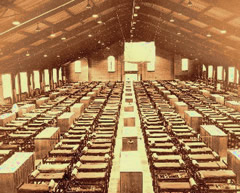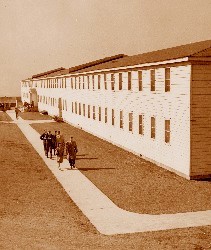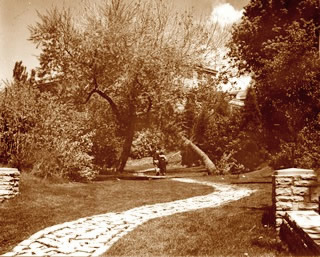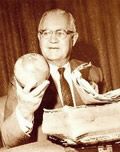|


|
Today’s students may live in a more diverse, technologically driven world and face different challenges than their colleagues of the many yesteryears that make up the University’s colorful history; yet, their concerns about the future and finances, and their hopes and aspirations tend to bridge generations.
Alumni who attended the University 40 or more years ago have attained
“emeritus”status. A select few here share snapshots
of their experience as students in the ’40s and ’50s,
reinforcing the notion that, while some aspects of student life
haven’t changed much, others have altered beyond recognition. |
Afton Bradford Bradshaw BA’47 MS’83, retired Utah state legislator
 |
The Einar Neilson
Fieldhouse was used to house soldiers during WWII. |
World War II greatly affected my college days. There were few men on campus, and many of them were serving in the Army, living in the [Einar Nielson] Fieldhouse, sleeping on cots. Coeds sold war bonds and stamps to help “stamp out Hitler.” Ration coupons were required to buy gasoline, sugar, and many other items. We watched the newspapers each day for two lists, those killed in action and those who were “only” wounded. Those were sober times.
As a 17-year-old freshman, I had no dream of becoming a doctor, lawyer, engineer, or even state legislator. Girls of my era were expected to become teachers, nurses, or secretaries. Hooray for today’s young women who can aspire to anything they choose. But they can’t pay just $33 for tuition, which was what my first quarter cost. And freshmen had to wear little green beanies. We painted the “rostrum” bright green in the middle of the night and the sophomores painted it red the next day. We walked around, never over, the University seal set in tile in the Park Building. It was a sin to tread on it. There was the thrill of two national basketball championships in 1944 and 1947. Best of all, I remember the excitement of learning, the beauty of our campus, and the friendships that are still treasured.
Robert Bennett BS’57, former student body president and current U.S. senator from Utah
 During
my senior year, the new A. Ray Olpin Union Building was dedicated on New
Year’s Day, 1957. Unfortunately, my most vivid memory of the event
is how miserable I felt. I had a bad case of the flu, bad enough that
I had to cancel my date for that night, and New Year’s Eve was spent
sniffling and aching in bed, just wishing the world would go away. However,
since I was student body president, I had to be at the dedication ceremonies.
I dragged myself to the new Union Building, cut the ribbon as quickly
as I could, and then went back home to try to get some more rest.
During
my senior year, the new A. Ray Olpin Union Building was dedicated on New
Year’s Day, 1957. Unfortunately, my most vivid memory of the event
is how miserable I felt. I had a bad case of the flu, bad enough that
I had to cancel my date for that night, and New Year’s Eve was spent
sniffling and aching in bed, just wishing the world would go away. However,
since I was student body president, I had to be at the dedication ceremonies.
I dragged myself to the new Union Building, cut the ribbon as quickly
as I could, and then went back home to try to get some more rest.
Tom Greene BA’52 JD’55, federal district court judge
 |
|
The Annex |
My involvement at the U was between 1947 and 1955. I majored in political science and law. Most of the classes were in the Annex and, while walking from there to the lower campus, I grew to appreciate the campus’ beauty and the history that overlaid the surroundings. A class on Utah History caused me to value more than ever the role of the fur trappers, the explorers, the Ute Indians, and Father Escalante, as well as the intrepid Mormon pioneers. All seemed to come alive. I could fantasize an acquaintance with the likes of Peter Skeen Ogden, Etienne Povost, John C. Fremont, Jim Bridger, John Wesley Powell, and other forerunners.
I recall meeting friends at the “pump” [water fountain] in the basement of the Park Building, and frequenting the College Inn, always referred to as the “CI,” for a Coke or Ironport. The best french fries and hamburgers I have ever tasted were at the Ute Hamburger stand. My memories go back to the great school spirit at the U Days celebration, Songfest, and Homecoming. We would always attend athletic events as a group to cheer on the team. I remember school dances, particularly the matinees. I think about certain teachers with great fondness and appreciation and, most of all, the lasting friendships that were made. All of this adds up to deep feelings of pride and loyalty for the University of Utah.
Norma Warenski Matheson BA’51, former first lady of Utah
 |
| Cottam's Gulch |
I remember with fondness the professors who energized me to obtain a degree in zoology: Walter Cottam, William Behle, and Kim Newby. Being one of a very few female students in the classes engendered enthusiastic offers of help. Why zoology? I credit the experience in those classrooms with providing me a lifelong interest in the environment. It was in Dr. Cottam’s class that I first heard the word “ecology.” Everyone remembers Cottam’s Gulch west of what was then the library. Dr. Behle’s ornithology class created a dedicated bird watcher out of me.
Earl Wunderli BA’56 JD’59, former student body president and retired IBM executive
I remember football coach “Pappy” Jack Curtis and basketball coach Jack Gardner. The games were played in Einar Nielsen Fieldhouse, where you received splinters from the old wooden bleachers and when BYU was no threat in any sport but still claimed “moral victories.” There was the Snow Carnival held each winter in Presidents Circle, outdoor musicals played in the stadium during the summer and, of course, the CI [College Inn], which was always packed and smoky, but is now a copy store. Aw, the good old days!”
Ted Capener BS’53, former sports editor of The Daily Utah Chronicle and later vice president of university relations and creator of Continuum
 It
may not have been the “best of times,” but it certainly seemed
like it. For a barely 17-year-old entering the U in the fall of 1949,
surrounded by older and wiser classmates, it could have been a fearful
time. Many students were veterans of [World War II], and they were serious
about their studies. It took me some time to arrive at that state. Reunited
with friends from East High (I had gone to South), and relying heavily
on the path that my older brother Buzz had plowed for me, I relished every
day. There was ping-pong or hearts at the Pi Kap house, challenging lectures
from outstanding professors, and more beautiful date potential than anyone
could dream of.
It
may not have been the “best of times,” but it certainly seemed
like it. For a barely 17-year-old entering the U in the fall of 1949,
surrounded by older and wiser classmates, it could have been a fearful
time. Many students were veterans of [World War II], and they were serious
about their studies. It took me some time to arrive at that state. Reunited
with friends from East High (I had gone to South), and relying heavily
on the path that my older brother Buzz had plowed for me, I relished every
day. There was ping-pong or hearts at the Pi Kap house, challenging lectures
from outstanding professors, and more beautiful date potential than anyone
could dream of.
While the Annex may not have been the fanciest place to learn, for many of us it was home. And learn we did. Socializing between classes in front of the old barracks could result in a date for the weekend. If you were unsuccessful there, the fallback spot was the library. The “quiet” room was off-limits, but the main reading room was excellent for meeting someone for the weekend dance. Our Union Building (now Libby Gardner Hall) was nothing like today’s A. Ray Olpin Union Building, but it was a beehive of activity, including occasional matinee dances.
Success led to the Rainbow to hear Nat “King” Cole, or Les Brown, or the Four Freshmen. Lagoon was another great spot for dancing. In fact, that was where the homecoming dance of l952 was held and, as chair of the homecoming committee, I helped book Champ Butler as the “name” attraction. The dance was a great success and topped a week of house decorations and skits. And although our theme, “Alumni Shadow Spooks Colorado,” didn’t result in a gridiron victory, the 20-to-14 loss was still very respectable. The 180-steps-per-minute marching band, under the direction of Ronald Gregory and drum majorette Frankie Robbins, was thrilling to watch that year, and the Utes went on to win the Skyline Conference championship.
Making a living became a serious consideration as the spring of 1953 approached. Graduation was arriving all too soon. In a long discussion, following nine holes of golf at Bonneville, our foursome decided that if we could be assured of $350 a month for the rest of our lives, we would be very well off.
Fifty years have passed since that graduation day, and the memories of those four wonderful years have warmed my very being ever since. I am a Utah man, sir, and will be ’til I die and, hopefully, beyond.
—Excerpt from “Memories of a Marvelous Time.”
Von Del Chamberlain BA’58, director of Hansen Planetarium from 1984 to 1996
 |
| Dr. A. Ray Olpin, president of the University of Utah, 1946-1964 |
What we remember is what we are. Memories come from all the trails our lives have taken. The people at the U have mattered the most. It was a mathematics professor who awoke in me the power of mathematical analysis. It was chemistry and physics teachers who excited my awareness of how we can begin to discern what the universe is like. And it was fellow students who helped me when I was not seeing meanings that they grasped more easily than I.
Music has been a highlight in my life. I belonged to the marching band, and my soul still stirs to 180 beats per minute whenever I hear “Utah Man.” The band went with the football team to Seattle to play in the rain at halftime. We spent the entire night on bench seats on the train, unable to find a place to sleep or to study. However, I thought I found such a place in one of the restrooms, but the regular intrusions did not inspire either sleep or intellectual pursuits.
On return, President Olpin spoke to us at a Sunday service and said something that made an indelible impression. It summarizes the way I feel about learning and about my education: “I used to think I knew I knew, But now I must confess, The more I know I know I know, I know I know the less.”
—Adapted from “Rekindling the Memories,”
compiled by Judge Regnal Garff BA’49 JD’55 MSW’56 for
the Fall 2003 issue of EmeriTalk, the Emeritus Alumni Association
newsletter.
